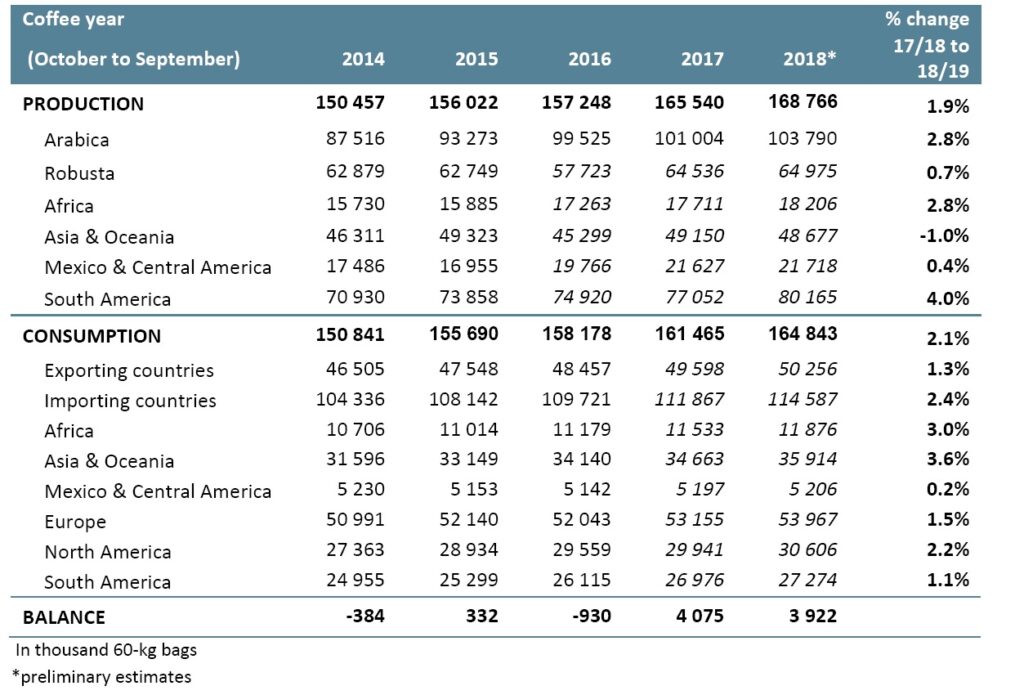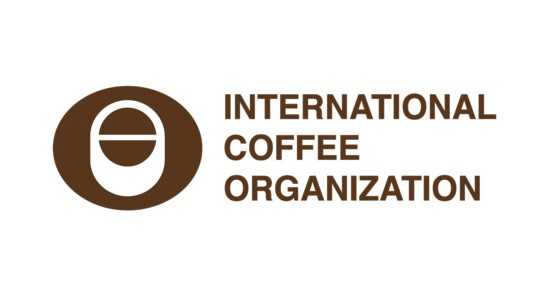LONDON, UK — The monthly average of the ICO composite indicator rose by 3% to 103.01 US cents/lb in July 2019, which is the highest monthly average since November 2018, states the International Coffee Organization in its monthly Coffee Market Report. However, the daily composite indicator started at a high of 107.87 US cents/lb on 4 July and fell to 98.57 US cents/lb by the end of the month. In June 2019, world coffee exports rose by 2.8% to 10.94 million bags compared to June 2018, while exports in the first nine months of coffee year 2018/19 rose by 6.5% to 97.28 million bags.
World production in coffee year 2018/19 increased by an estimated 1.9% to 168.77 million bags, led by a 18.5% increase in Brazil’s production for the crop year ending March 2019. Global consumption in 2018/19 grew by an estimated 2.1% to 164.84 million bags. Although consumption growth outpaced production, the cumulative surplus over the last two seasons rose to 8 million bags.
The ICO composite indicator averaged 103.01 US cents/lb in July 2019, 3% higher than in June 2019. This marks the first time the average price reached over 100 US cents/lb since February 2019 when the price averaged 100.67 US cents/lb. The daily composite indicator arrived at its highest point, 107.87 US cents/lb, on 4 July, but slowly declined over the next few weeks. It reached 98.57 US cents/lb on 31 July. Concerns over frost that supported prices in late June and early July dissipated by the end of the month.
Average prices for the Arabica group indicators rose in July 2019. Prices for Brazilian Naturals experienced the largest increase, averaging 105.43 US cents/lb, 4.7% higher than in June 2019. Other Milds increased by 4.4% to 135.47 US cents/lb while Colombian Milds rose 3.1% to 137.63 US cents/lb. Given the larger increase in Other Milds prices, the differential between Colombian Milds and Other Milds fell by 42.6% to 2.16 US cents/lb. In contrast to the Arabica group indicator prices, Robusta prices decreased by 0.1% to 73.93 US cents/lb, which is 13.3% lower than the start of the coffee year.
In June, the arbitrage between Arabica and Robusta coffees, as measured on the New York and London futures markets increased for the fourth consecutive month to 44.18 US cents/lb, 13.2% than in June 2019. Intra-day volatility of the ICO composite indicator price rose by 0.3 percentage points to 9.2% as the intra-day volatility of the Arabica group indicators rose.
Amongst the Arabica group indicators, the intra-day volatility of Brazilian Naturals rose by 1 percentage point to 12%, of Other Milds by 0.7 percentage points to 9.7%, and of Colombian Milds by 0.2 percentage points to 8.7%. However, the intra-day volatility of Robusta declined to 6.9%, 1.7 percentage points lower than last month.
In June 2019, world coffee exports rose by 2.8% to 10.94 million bags compared to June 2018. This growth was led by shipments of Colombian Milds, which grew by 19.9% to 1.23 million bags. Exports of Brazilian Naturals grew by 8.8% to 2.91 million bags in June 2019 compared to the same month one year ago. Exports of Other Milds rose by 0.6% to 2.93 million bags. Robusta exports decreased by 4% to 3.86 million bags in June 2019.
Global exports in the first nine months of coffee year 2018/19 reached 97.28 million bags, an increase of 6.5% compared to the same period one year ago. Shipments of Brazilian Naturals rose by 20.6% to 31.12 million bags while Colombian Milds increased by 8.1% to 11.36 million bags. Robusta exports increased by 1.4% to 34.45 million bags in October 2018 to June 2019 while Other Milds fell by 3.3% to 20.35 million bags.
The decrease in Other Milds is driven by India, Mexico, and Costa Rica where exports decreased by 9.2% to 4.69 million bags, by 11.8% to 2.11 million bags, and by 12.3% to 785,601 bags, respectively.
In coffee year 2018/19, world production is estimated by the ICO at 168.77 million bags, with Arabica output, estimated at 103.79 million bags, accounting for 61% and Robusta, estimated at 64.98 million bags, representing 39% of the total. Output in the five largest producers this coffee year would account for 73% of world production.
Brazil’s production in crop year ending March 2019 increased by 18.5% to 62.5 million bags, which is reflected in the 20.6% increase in its exports this period, reaching 37.13 million bags. Brazil’s Robusta production has recovered from the previous drought as evidenced by the growth in green Robusta exports.
After declining by 72% to 119,146 bags in the first six months of 2017, exports more than tripled to 505,912 bags in January to June 2018 and increased to 1.46 million bags in the first six months of 2019. Brazil’s exports of green Arabica in the first half of 2019 reached 15.86 million bags compared to 12.42 million bags last year.
Vietnam’s production is estimated 1.3% lower at 30 million bags as adverse weather conditions affected the yield in crop year 2018/19. Despite the reduction, output in 2018/19 would be the second largest volume on record for Vietnam following 2017/18. Its exports in the first nine months of the year declined by 3.9% to 21.1 million bags.
Output from Colombia is estimated at 13.95 million bags in 2018/19, 1% higher than last year. According to the National Federation of Coffee Growers, production from October 2018 to June 2019 reached 10.34 million bags, 1.1% lower than the same period in 2017/18. However, exports from Colombia in the first nine months of coffee year 2018/19 amounted to 10.17 million bags, an increase of 7% from last year. Its shipments of soluble exports have grown steadily in recent years. In 2015/16, soluble exports represented around 5% of total exports, while in 2018/19 they represent around 6%. Colombia’s imports in the first half of coffee year 2018/19 increased to 865,024 bags from 288,115 bags during the same period in 2017/18, with imports of green coffee accounting for 95.8% of total imports this year.
Indonesia’s production declined by 5.6% to 10.2 million bags in its crop year ending March 2019. Shipments during crop year 2018/19 declined by 33.7% to 5.15 million bags. In addition to the decline in output, steadily increasing consumption has reduced the availability of coffee for exports. Around 75% of Indonesia’s green coffee exports are shipments of green Robusta, which reached 2.06 million bags in the first nine months of the coffee year compared to 2.44 million bags last year. The share of soluble in the total exports has increased from 5.9% in 2010/11 to 20.7% in 2018/19. Total soluble shipments in the first nine months amounted to 749,372 bags.
Production in Ethiopia is estimated at 7.5 million bags, 0.6% higher than in crop year 2017/18. While Ethiopia is the world’s fifth largest producer, it is the ninth largest exporter given the high rate of domestic consumption. In 2018/19, Ethiopia’s consumption is estimated at 3.8 million bags, which represents 50.7% of its expected output. Exports in the first nine months of coffee year 2018/19 amounted to 2.47 million bags compared to 2.65 million bags in 2017/18.
 World coffee consumption is estimated 2.1% higher in coffee year 2018/19 at 164.84 million bags with the largest growth in Asia & Oceania where demand rose by 3.6% to 35.91 million bags. Consumption in Europe has slowed, increasing by 1.5% to 53.97 million bags compared to an increase of 2.1% in 2017/18. However, demand in North America grew by 2.2% to 30.61 million bags.
World coffee consumption is estimated 2.1% higher in coffee year 2018/19 at 164.84 million bags with the largest growth in Asia & Oceania where demand rose by 3.6% to 35.91 million bags. Consumption in Europe has slowed, increasing by 1.5% to 53.97 million bags compared to an increase of 2.1% in 2017/18. However, demand in North America grew by 2.2% to 30.61 million bags.
Consumption in South America increased by 1.1% to 27.27 million bags, in Africa by 3% to 11.88 million bags, and in Central America & Mexico by 0.2% to 5.21 million bags. Despite this growth, world production is expected to exceed consumption by 3.92 million bags, resulting in a cumulative surplus of 8 million bags over the last two seasons.
















